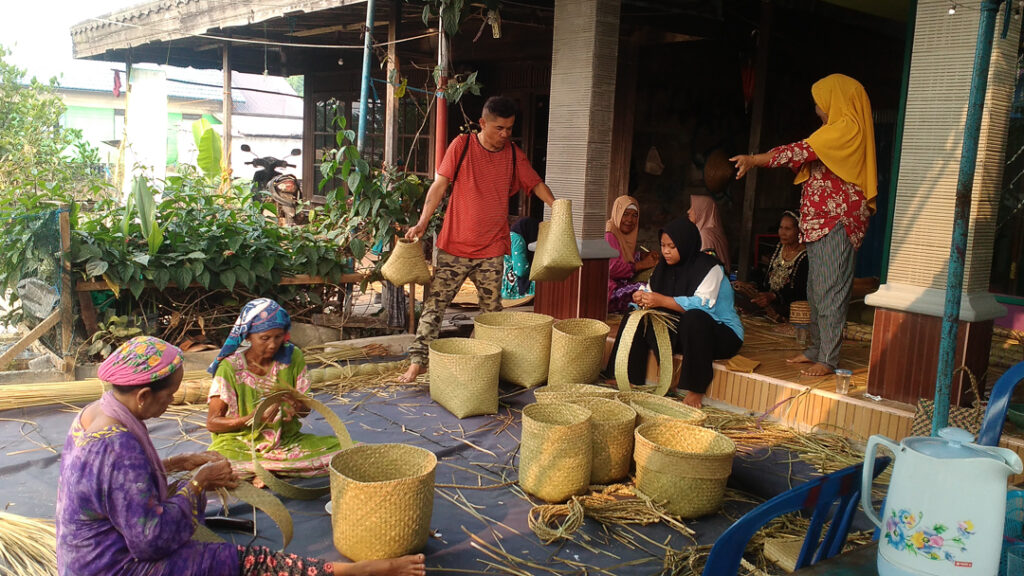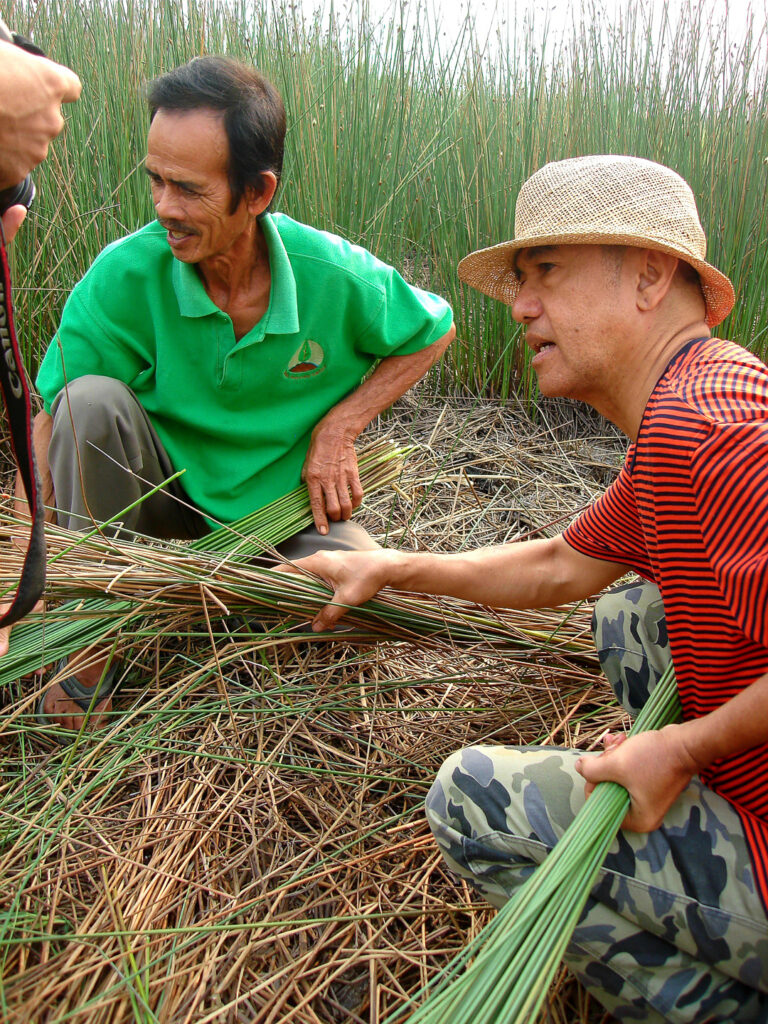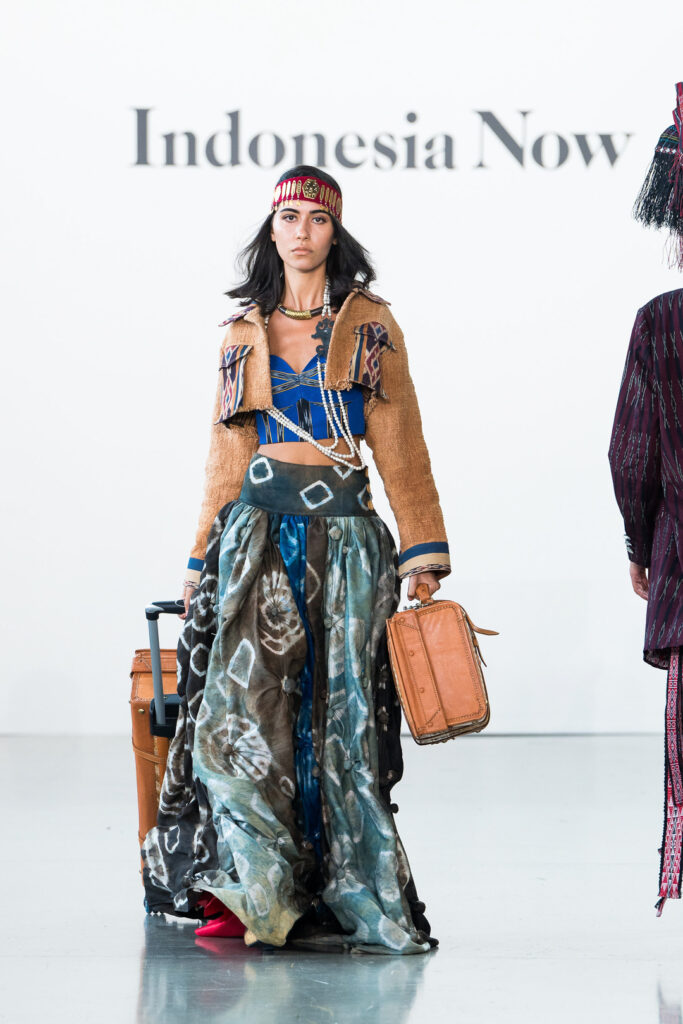
Myra Suraryo profiles the Purun Goods collection designed by Merdi Sihombing with the communities of South Sumatra & South Kalimantan.
(A message to the reader in Indonesian.)
(A message to the reader in English.)
Peatland, a particular ecosystem in which waterlogging prevents the complete decomposition of plant material, results in the net accumulation of organic matter known as peat. Purun, a unique weed plant exclusively found in peatlands, has been utilized by indigenous communities for various daily necessities. Purun, a flammable material, gained significant attention from the world due to its role in the devastating fires that ravaged Indonesia in 2015, affecting over 50% of peatlands.
In response to this crisis, Indonesia has intensified efforts to protect and restore these carbon-rich ecosystems, which are also prime locations for agricultural expansion. Transforming peatland management is crucial for achieving Indonesia’s commitment to reduce greenhouse gas emissions and mitigate the damaging impacts of fires, including school closures, respiratory issues, and premature deaths.
The Peat Restoration Agency of the Republic of Indonesia (BRG) was tasked with restoring 2.49 million hectares of degraded peatland across seven priority provinces. The agency employs a three-pronged approach: rewetting, revegetation, and revitalizing local people’s livelihoods. The latter approach focuses on improving the welfare of those residing within or near the peat ecosystem through sustainable peat management.
In many peatland villages, one livelihood option is the utilization of native peat commodities like purun, a peat sedge plant found in Indonesia and neighboring countries. Purun has traditionally been used as raw material for homemade crafts, primarily mats, by communities living near peatlands.
Purun provides additional economic benefits, particularly for women. The mats made from purun are sold in other villages, major cities, and even outside the province, mainly through middlemen or middlewomen. A weaver can make a significant number of mats in a month and earn a reasonable income, which is used to support their household’s daily needs and provide personal necessities.
Despite the potential of Purun weaving to improve the welfare of women in the village, several challenges need to be addressed. Firstly, the supply of raw materials has been decreasing due to peat degradation and land conversion, affecting the livelihood and cultural significance of Purun weaving.
Secondly, limited access to capital is another key issue faced by weavers. They are often forced to borrow money from middlemen, leading to a cycle of debt and low bargaining power.
Lastly, there is a knowledge gap between market demands and the existing supply. Most weavers produce simple, low-cost mats due to the ease of production and quick sales. However, there is a significant demand for high-quality, value-added purun products, such as stylish handbags, hats, and other household products, which can be sold at higher prices.
To address these challenges, the local governments of South Sumatra & South Kalimantan, in collaboration with non-governmental organizations and the private sector, can take several measures. Strengthening the protection of peatland ecosystems, preserving traditional purun weaving knowledge, and providing equitable financing mechanisms can contribute to the success and sustainability of purun weaving.
Furthermore, improving weavers’ access to design inspiration, creative weaving techniques, and innovative marketing tools can expand their market reach and tap into environmentally conscious buyers. By addressing these challenges and capitalizing on the potential of purun weaving, it can become a sustainable and empowering livelihood option for women in peatland areas and support BRG’s efforts to restore degraded peatlands in South Sumatra & South Kalimantan.
Amidst the unprecedented challenges posed by the COVID-19 pandemic in 2020, a beacon of creativity and resilience emerged within the fashion industry. In response, the “Purun project” was born. This community development project was initiated by BRG (Indonesian: Badan Restorasi Gambut Republik Indonesia), with the support of the United Nations Development Program (UNDP) in Indonesia. Led by renowned Indonesian indigenous fashion designer Merdi Sihombing, with the lofty aim of improving the living conditions of peatland communities, the project centered on revitalizing the Purun plant in South Sumatra and South Kalimantan, aiming to enhance the economic worth of Purun-based products.
The choice of the name “Purun” was not merely a matter of convenience; derived from the name of the only plant capable of thriving in peatland regions, it also reflected the project’s commitment to simplicity, ease of pronunciation, and memorability. Beyond its practical considerations, the name also served as a powerful symbol of the project’s aspiration to raise awareness about purun, a plant often overlooked and underutilized in Indonesia despite its inherent beauty and potential.
At the heart of the Purun Project was the eponymous fashion film, directed with artistic flair and precision by a visionary film director, Ignatius Raditya Bramantya, more popular as Bramsky (IG @bramsky.bramsky). The film showcased a breathtaking array of clothing and accessories meticulously crafted from purun, in a later collection, titled “Purun Goods,” by Merdi Sihombing. Each design was a testament to the Merdi’s deep appreciation for the plant’s unique qualities, as well as his profound understanding of the traditional culture of the people who call the peatlands their home.
The materials employed in the “Purun Goods” collection were sourced directly from the purun plant, which thrives near water bodies and in swampy areas. Purun’s significance extends beyond its aesthetic appeal; it plays a crucial role in maintaining peatland hydrology, preserving the delicate balance of flora and fauna, and ensuring the sustainability of microbial communities. By incorporating purun into fashion, the project aimed to celebrate the intrinsic connection between nature and human creativity.
The “Purun Goods” collection involved the active participation of women of diverse ages, from teenagers to adults and the elderly, who reside in communities adjacent to peatlands. These women were instrumental in every stage of the project, from harvesting the purun to weaving it into intricate textiles and ultimately creating the final products. Their involvement not only enriched the project with their traditional knowledge and skills but also provided a platform for economic empowerment and social recognition.
- Merdi Sihombing
Merdi Sihombing and his dedicated team meticulously developed the design concept for the “Purun Goods” collection. Their vision was to elevate purun woven products beyond their traditional context and introduce them to a wider audience. By combining traditional techniques with contemporary aesthetics, they sought to popularize purun woven products and bestow upon them a new level of sophistication and elegance.
The “Purun Goods” collection was first showcased during the Antwerp Fashion Week held in Antwerp, Belgium, in the year 2018. Since then, the collection has been showcased in numerous international fashion weeks, including the New York Fashion Week SS 23/24 held in September 2023, and the Global Indigenous Runway part of PayPal Melbourne Fashion Festival in 2023 and 2024.
The “Purun” fashion film, initially intended as a project completion report, achieved remarkable success, garnering widespread recognition from fashion enthusiasts and the general public alike, including the Best Fashion Film award in PayPal Melbourne Fashion Festival 2024. The film showcased the stunning beauty and versatility of purun, while also emphasizing the urgent need to preserve and protect the peatland ecosystem. Additionally, it highlighted the significant role of local communities in safeguarding their natural heritage and promoting sustainable livelihoods. The film shed light on the invaluable contributions of these communities, earning widespread acclaim and praise.
The success of the “Purun Goods” collection extended far beyond the realm of fashion. It served as a powerful reminder of the transformative potential of creativity, collaboration, and respect for the environment. By embracing the beauty of purun and empowering local communities, the project paved the way for a more sustainable and equitable future, where fashion and nature coexist in harmony.
As a testament to the remarkable potential that arises when art and sustainability intertwine, the Purun Project stands as a beacon of hope. By showcasing the beauty of purun and supporting the livelihoods of local communities, this initiative has set a precedent for future endeavors that harmoniously merge fashion and environmental stewardship. The “Purun Goods” collection transcends mere fashion, evolving into a powerful symbol of hope and resilience, serving as a poignant reminder of the urgent need to protect our planet and its intricate ecosystems.








